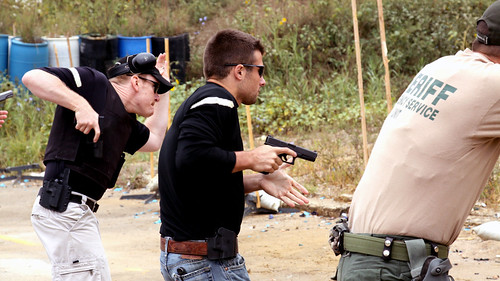Striker-Fired
A striker-fired pistol is one that operates without a traditional hammer. After cocking the slide, the firing pin will be held back and a spring loaded ready to release on trigger pull and send the firing pin forward.
Scenario Uno: The Soft Strike
You load a magazine, rack the slide, aim, squeeze… and nothing. Maybe it’s the firing pin, maybe it’s the primer. Either way let’s hit it again.
On a striker-fired pistol you can reset the firing pin and trigger by pulling the slide back an inch or two. You should see your trigger reset and you’re ready to try again. Or, of course, rechambering another round altogether. Rating: OK
Scenario Two: The Winter Draw
You decide to go for a walk one winter night and dress appropriately. Part way along your stroll you’re surprised by what looks like a rabid dog. Time is of the essence; you pull up your coat and draw. Your pistol exits smoothly and you’re able to crack off a warning shot between you and the animal scaring it away. What else could have happened there? Rating: Great
Scenario Three: Dry Fire Training
Pretty straight forward! You want to practice via dry fire. What do we do? Rerack the slide either partially or fully every time to reset the trigger. Not entirely convenient but it works for practicing trigger control and grip. Rating: OK
Single Action Hammer Fired Pistols
Not to be confused with single action revolvers that only fire after the hammer is pulled. When pulling the slide back all the way and releasing it on a single action hammer pistol, the hammer will remain pulled back. One trigger pull it will release striking the firing pin.
Scenario One: The Soft Strike
Pulled the trigger and nothing happened. What do we do? Pull the hammer back and try again! Or rerack and chamber another round. With a single action pistol the trigger won’t operate unless the hammer is fully back. Be wary of “half-cocking” as well. Many pistols have three hammer positions, forward, half, and back. A half-cocked hammer won’t do anything; hence, the old expression! Rating: OK
Scenario Two: The Winter Draw
Here we are again face to face with a rabid dog. You reach for your trust 1911 and what happens?
Unfortunately, that old raggedy thermal you threw on snagged the hammer. You waste a couple precious seconds clearing your weapon before you’re able to react! Is this guaranteed to happen?
No. Especially if you’re aware of the possibility and take the proper precautions. Practice your draw in your winter clothing, your spring clothing, formal wear, you get the idea. Knowing how what you’re wearing impacts your ability to draw can save your life, and prevent you accidentally shooting yourself to boot. Rating: OK
Scenario Three: Dry Fire Training
Practice time. Pull the hammer back, squeeze trigger, rinse, and repeat. Not as bad as a striker-fired since all we have to do is pull the hammer back. Rating: OK
Double Action Hammer Fired
Not to be confused with double-action revolvers, but very similar in function. A double action pistol has a hammer. The trigger can be pulled whether the hammer is forward or back. If a round is in the chamber a double action pistol will fire even if it’s been de-cocked. When pulling the trigger with the hammer forward the weight will be heavier than if the hammer was cocked. You’ll see two trigger pull weights for double action pistols.
Double action pistols can also sometimes be confused with striker-fired ones if you’re not paying attention. Some double action pistols are “double action only” and have a hidden hammer. The rear of the slide is smooth much like a striker-fired pistol with only an outline of the “hammer”. These can’t be cocked into single action mode and only fire in double action.
Scenario One: The Soft Strike
Literally just pull the trigger again. It’s that easy!
Alternatively, you can pull the hammer back for a lighter trigger pull if you’re at the range. In a defensive scenario this can be incredibly advantageous. Of course, it may be better to just cycle the slide and get another round in. Rating: Great
Scenario Two: The Winter Draw
Here we have two different ways things can play out. Since we have double action pistols that are “hammerless,” fire double action only with no exposed hammer, there’s less chance of snagging.
With a tradition double action pistol with an exposed hammer, we have a higher chance of getting caught up. This can obviously be a big issue. To try and prevent this make sure to practice your draw in your winter gear. Most of us, including myself, are probably guilty of practicing our draw in minimal casual clothing since we’re at home. Rating: OK
Scenario Three: Dry Fire Training
Cock the hammer or don’t. Just squeeze the trigger for a double action pull weight for pull the hammer back for a single action pull weight if you have an exposed hammer.
For those laser systems that depend on the firing pin to register your shots the double-action has no competition. Sure, you’re more than likely not going to be firing in double action the whole time in the real world, but that tougher trigger pull is making your finger stronger. After a while of double action only pulls the weight of single action will feel a lot lighter. Rating: Great
Final thoughts
There are some obvious advantages and disadvantages to each system. While striker-fired also have lower bore axis heights, a whole other story, hammer fired pistols tend to be all metal and absorb recoil a little better. The point here isn’t really to try and sway you one way or another but to know how each may perform under certain circumstances. Just as always, be safe, and check your chambers. Good luck!


